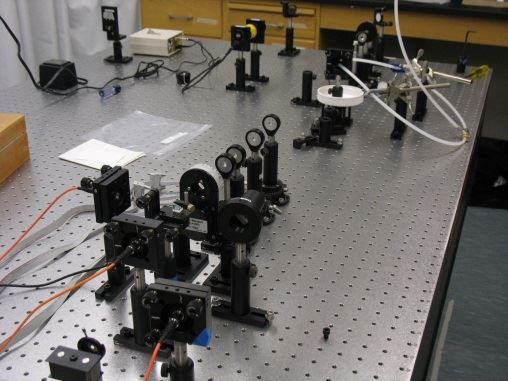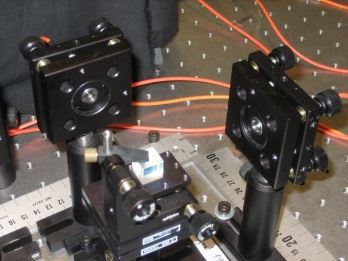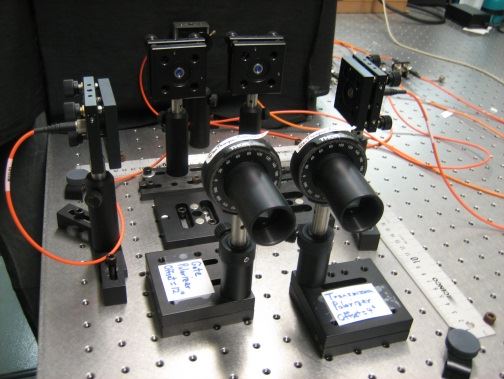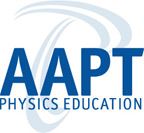- Home
- What We Do
- Laboratory Immersions
- Immersions 2020
- Imm2020HarveyMudd_quantum
Quantum Mechanics Experiments with Single Photons and Entangled Photons
Harvey Mudd

Figure 1: Overview of optical beam path, from pump laser at the far end of the table to fiber couplers in the foreground.
In this immersion, participants will use a simple apparatus that produces near-IR photons in pairs via the process of spontaneous parametric downconversion in a nonlinear crystal, and detects them via photon-counting silicon avalanche photodiodes. The photon pairs allow for two general categories of investigation. First, we can conduct experiments on individual photons by using one member of a pair to “herald” the existence and arrival of the other member, on which the single-photon experiments are carried out. Participants will use this approach to observe the existence of single light quanta (photons), by seeing that photons incident one at a time on a beamsplitter never produce simultaneous clicks on both output ports. We will then observe that photons incident one at a time on an interferometer nevertheless exhibit interference fringes, highlighting the wave/particle duality.

Figure 2: Beamsplitter and fiber couplers for existence of single photons experiment.
The second category of investigation makes use of the quantum-mechanical entanglement between the paired downconversion photons, most notably in their polarizations. Participants will read about and discuss Bell’s inequality, and perform a measurement of polarization correlations that clearly violates Bell’s inequality and thus rules out local hidden variable theories as an alternative to quantum mechanics.

Figure 3: Polarizers and fiber couplers for violation of Bell’s inequality.
The Immersion will be three days long. The intent is to make it feasible for participants to introduce the experiments at their home campuses (total equipment cost is about $20K-$26K, but campuses may own some components already); thus we will address alignment of the optical elements and setup and calibration of the photon-counting electronics, as well as data acquisition, analysis, and interpretation. Reading from lab manuals and selected journal articles will be assigned beforehand; participants should bring their reading, reading notes, and a lab notebook. Laser safety goggles—to be worn on their own or over prescription glasses—will be provided on site, and should be worn as directed during experimental work.
Host and Mentors
Theresa Lynn received her B.A. in physics from Harvard, and her M.S. and Ph.D. in physics from the California Institute of Technology. She was a postdoctoral scholar and staff scientist at Caltech before joining the faculty at Harvey Mudd College in 2006. Her research experience spans many areas of atomic and optical physics, including laser cooling and trapping, atom optics, cavity QED, and quantum information. Currently her research focuses on quantum communication, particularly experiments with entangled photons. Theresa has taught a wide range of courses at Harvey Mudd, including the upper-division laboratory courses in which students conduct the experiments in this Immersion. She recently designed a new introductory lab course for the department, and is currently refining an undergraduate quantum information textbook, which she is using in a course for the second time this year.
Theresa Lynn, Associate Professor of Physics, Harvey Mudd College, Department of Physics, 301 Platt Blvd., Claremont CA 91711. Email: lynn@hmc.edu. Telephone: 909-607-4493
Dick Haskell received his BS in engineering physics from Lehigh University and his PhD in nuclear physics from Johns Hopkins University. As a postdoctoral fellow at JHU, he continued to measure magnetic dipole moments of beta-unstable nuclei at 3 to 10 MeV accelerators at Brookhaven and Los Alamos National Laboratories. In 1974 he moved to the Biophysics Department at Johns Hopkins and devoted six years to laser light-scattering studies of skeletal muscle. He joined the physics faculty at Harvey Mudd College in 1980 where his interests in biophysics have focused on laser diagnostics of tissue and optical coherence microscopy in developmental biology and tissue engineering. In particular, he is studying events in the early development of the frog, Xenopus laevis, and is contributing to the tissue-engineering of a human replacement cornea. While he has taught a broad array of undergraduate courses at Mudd, he particularly enjoys the upper division laboratory courses where he collaborates with students on the quantum optics and quantum mechanics experiments featured in this workshop.
Richard Haskell, Professor of Physics, Harvey Mudd College, Department of Physics, 301 Platt Blvd., Claremont CA 91711. Email: haskell@g.hmc.edu. Telephone: 909-607-276
Please note that the Jonathan F. Reichert Foundation has established a grant program to help purchase apparatus used in Laboratory Immersions. Limitations and exclusions apply, but generally speaking the foundation may support up to 40% of the cost of the required equipment.




